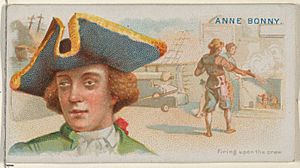Anne Bonny facts for kids
Quick facts for kids
Anne Bonny
|
|
|---|---|
| Born | ca. 1697–1700 near Cork, Kingdom of Ireland
|
| Disappeared | April 1721 (aged 24) Port Royal, Colony of Jamaica |
| Spouse(s) | |
| Piratical career | |
| Nickname | Anney |
| Type | Pirate |
| Allegiance | Calico Jack |
| Years active | 1718–October 1720 |
| Base of operations | Caribbean |
Anne Bonny (born around 1697–1700, disappeared April 1721) was an Irish pirate. She sailed in the Caribbean Sea. Anne Bonny was one of the few known female pirates in history. Most of what we know about her comes from a book. This book, A General History of the Pyrates, was written by Captain Charles Johnson in 1724.
Anne Bonny was born in Ireland around 1700. When she was about 10, she moved to London. Later, she moved to the Province of Carolina in America. Around 1718, she married a sailor named James Bonny. She took his last name. They moved to Nassau in the Bahamas. This place was a safe spot for pirates. There, she met Calico Jack Rackham. She became his partner in piracy. She was caught with Rackham and Mary Read in October 1720. All three were sentenced to death. However, Bonny and Read were pregnant. This meant their executions were delayed. Read died in jail in April 1721. Anne Bonny's final fate is not known.
Contents
Anne Bonny's Early Life
Anne Bonny was likely born around 1700. She was born in County Cork, Ireland. Her mother was Mary Brennan, a servant. Her father was William Cormac, a lawyer. Not many official records exist about her life. Most information comes from Charles Johnson's book.
Her father, William Cormac, moved to London. He wanted to get away from his wife's family. He even dressed Anne as a boy and called her "Andy." Later, he moved to the Province of Carolina. Anne and her mother went with him. Her father changed their family name to "Cormac." This helped them fit in better in Charles Town.
At first, life was hard for them. But her father knew about law and trade. He soon earned enough money for a house and a plantation. Anne's mother died when Anne was 12. Her father became a successful merchant.
Anne Bonny was known for her red hair. She was considered a good match for marriage. But she also had a strong temper. She married a sailor named James Bonny. He was not wealthy. Anne's father did not approve of James. He disowned Anne. This means he cut her off from his family and money.
Anne and James Bonny moved to Nassau. This was on New Providence Island. It was a famous place for English pirates. Many pirates there had received a King's Pardon. This pardon forgave their past crimes. In 1718, Governor Woodes Rogers arrived. James Bonny became an informant for the governor. He reported pirates to Governor Rogers. Anne did not like her husband's work.
Joining Calico Jack Rackham
In the Bahamas, Anne Bonny spent time with pirates. She met John "Calico Jack" Rackham. They became close. Rackham offered money to James Bonny to divorce Anne. But James refused. He even threatened Rackham. Anne and Rackham then left the island together. Anne joined Rackham's pirate crew.
She dressed as a man on the ship. Only Rackham and Mary Read knew she was a woman. Later, it became clear she was pregnant. Rackham took her to Cuba. There, she gave birth to a son. She then rejoined Rackham and continued her pirate life. She had divorced James and married Rackham at sea.
Bonny, Rackham, and Read stole a ship called the William. It was anchored in Nassau harbor. They sailed away and found new crew members. Their crew spent years pirating near Jamaica. Anne Bonny fought alongside the men. Governor Rogers even put her name on a "Wanted Pirates" list. This list was published in The Boston News-Letter.
Capture and Imprisonment
In October 1720, Rackham's crew was attacked. A sloop led by Jonathan Barnet captured them. This happened under orders from Nicholas Lawes, the Governor of Jamaica. The pirates were taken to Jamaica. Governor Lawes found them guilty and sentenced them to be hanged.
Both Mary Read and Anne Bonny said they were pregnant. This was called "pleading their bellies." The court delayed their executions until they gave birth. Mary Read died in prison. She likely died from a fever after childbirth. A church record in Jamaica shows her burial on April 28, 1721. It lists her as "Mary Read, pirate."
What Happened to Anne Bonny?
There is no clear record of Anne Bonny being released from prison. This has led to many ideas about what happened to her. One record shows an "Ann Bonny" buried on December 29, 1733. This was in the same town in Jamaica where she was tried.
Charles Johnson wrote in his 1724 book: "She was continued in Prison, to the Time of her lying in, and afterward reprieved from Time to Time; but what is become of her since we cannot tell; only this we know, that she was not executed." This means she was not hanged.
Other stories say she might have gone back to the United States. Some believe she died in South Carolina in April 1782. Her true fate remains a mystery.
Statue
In 2020, a statue of Anne Bonny and Mary Read was revealed. It is located at Execution Dock in Wapping, London. There are plans to move the statue to Burgh Island in south Devon.
Images for kids
See also
 In Spanish: Anne Bonny para niños
In Spanish: Anne Bonny para niños



